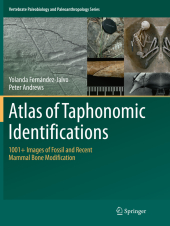 Neuerscheinungen 2018Stand: 2020-02-01 |
Schnellsuche
ISBN/Stichwort/Autor
|
Herderstraße 10
10625 Berlin
Tel.: 030 315 714 16
Fax 030 315 714 14
info@buchspektrum.de |

Peter Andrews, Yolanda Fernandez-Jalvo
(Beteiligte)
Atlas of Taphonomic Identifications
1001+ Images of Fossil and Recent Mammal Bone Modification
Softcover reprint of the original 1st ed. 2016. 2018. ix, 359 S. 820 SW-Abb., 311 Farbabb., 6 Tabellen,
Verlag/Jahr: SPRINGER NETHERLANDS; SPRINGER 2018
ISBN: 9402413480 (9402413480)
Neue ISBN: 978-9402413489 (9789402413489)
Preis und Lieferzeit: Bitte klicken
The aim of the atlas is to provide images of taphonomic modifications, making it as comprehensive as possible with evidence presently available. This volume is intended both as a field guide for identifying taphonomic modifications in the field, and for use in the laboratory when collections of fossils are being analyzed. Images in the book are a combination of scanning electron micrographs, regular photographs, cross-sections of bones and line drawings and graphs. By providing good quality illustrations of taphonomic modifications, with links between similar types of modification, the atlas provides a reference source for identifying the agents responsible for the modifications, the processes by which they were formed, and the potential bias introduced by the processes.
The authors also aim to emphasize on the directions they consider taphonomic studies should be headed. Firstly, we should seek to quantify the degree of bias introduced into a fossil fauna and to take account of this bias before interpreting the palaeoecology of the fossil site. Secondly, we should recognize that taphonomic modifications increase the information encoded in fossils by identifying perimortem and postmortem context s. This provides a more dynamic and realistic view of the past.
Introduction and Rationale.- Methods in Taphonomy.- Part I: Surface Modifications.- Linear Marks.- Pits and Perforations.- Discoloration and Staining.- Part II: Modifications Affecting Shape.- Abrasion and Rounding.- Part III: Modifications Penetrating Bone Tissue.- Flaking and Cracking.- Corrosion and Digestion Corrosion.- Part IV: Modification by Loss of Bone Tissue or Skeletal Elements.- Breakage and Deformation.- Disarticulation and Completeness.- Part V: Conclusions.- Why Taphonomy?.


